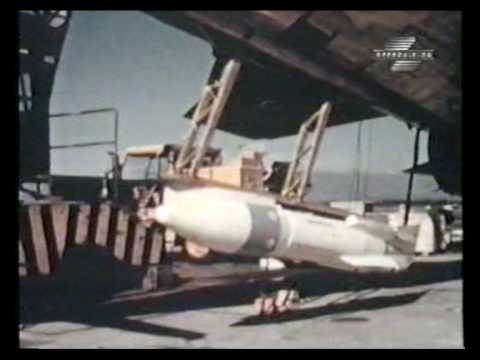The Douglas Genie (MB-1 Ding-Dong, AIR-2) was an unguided air-to-air rocket with a 1.5kt W25 nuclear warhead. It was deployed by the United States Air Force (USAF) (from 1957) and the Canadian Forces Air Command (from 1965 to 1984) during the Cold War. Production ended in 1962 after over 3000 were produced, with some related training and test derivatives occurring later.
The resultant weapon carried a 1.5-kiloton W25 nuclear warhead and was powered by a Thiokol SR49-TC-1 solid-fuel rocket engine of 162 kN (36,500 lbf) thrust. It had a range of slightly under 10 km (6.2 mi). Targeting, arming, and firing of the weapon were coordinated by the launch aircraft’s fire-control system. Detonation was by time-delay fuze, although the fuzing mechanism would not arm the warhead until engine burn-out, to give the launch aircraft sufficient time to turn and escape. Lethal radius of the blast was estimated to be about 300 meters (1,000 ft).
The first test firings of inert rounds took place in 1956, and the weapon entered service with the designation MB-1 in 1957. The popular name was Genie, but it was often nick-named ‘Ding-Dong.’ About 3,150 rounds were produced before production ended in 1963. In 1962 the weapon was redesignated AIR-2A Genie. Many rounds were upgraded with improved, longer-duration rocket motors, the upgraded weapons sometimes known (apparently only semi-officially) as AIR-2B. An inert training round, originally MB-1-T and later ATR-2A, was also produced in small numbers.
A live Genie was detonated only once, in Operation Plumbbob on 19 July 1957. It was fired by AF Captain Eric William Hutchison flying a F-89J over Yucca Flats at an altitude of 4,500 m (15,000 ft). A group of five USAF officers volunteered to stand hatless in their light summer uniforms underneath the blast to prove that the weapon was safe for use over populated areas. They were photographed by George Yoshitake who stood there with them. Gamma and neutron doses received by observers on the ground were negligible. Doses received by aircrew were highest for the fliers assigned to penetrate the airburst cloud ten minutes after explosion.

